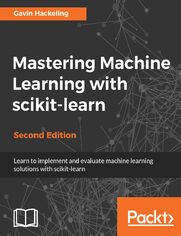Mastering Machine Learning with scikit-learn - Second Edition - Helion

Tytuł oryginału: Mastering Machine Learning with scikit-learn - Second Edition
ISBN: 9781788298490
stron: 249, Format: ebook
Data wydania: 2017-07-24
Ksi─Ögarnia: Helion
Cena ksi─ů┼╝ki: 125,10 z┼é (poprzednio: 139,00 z┼é)
Oszczędzasz: 10% (-13,90 zł)
Use scikit-learn to apply machine learning to real-world problems
About This Book
- Master popular machine learning models including k-nearest neighbors, random forests, logistic regression, k-means, naive Bayes, and artificial neural networks
- Learn how to build and evaluate performance of efficient models using scikit-learn
- Practical guide to master your basics and learn from real life applications of machine learning
Who This Book Is For
This book is intended for software engineers who want to understand how common machine learning algorithms work and develop an intuition for how to use them, and for data scientists who want to learn about the scikit-learn API. Familiarity with machine learning fundamentals and Python are helpful, but not required.
What You Will Learn
- Review fundamental concepts such as bias and variance
- Extract features from categorical variables, text, and images
- Predict the values of continuous variables using linear regression and K Nearest Neighbors
- Classify documents and images using logistic regression and support vector machines
- Create ensembles of estimators using bagging and boosting techniques
- Discover hidden structures in data using K-Means clustering
- Evaluate the performance of machine learning systems in common tasks
In Detail
Machine learning is the buzzword bringing computer science and statistics together to build smart and efficient models. Using powerful algorithms and techniques offered by machine learning you can automate any analytical model.
This book examines a variety of machine learning models including popular machine learning algorithms such as k-nearest neighbors, logistic regression, naive Bayes, k-means, decision trees, and artificial neural networks. It discusses data preprocessing, hyperparameter optimization, and ensemble methods. You will build systems that classify documents, recognize images, detect ads, and more. You will learn to use scikit-learn's API to extract features from categorical variables, text and images; evaluate model performance, and develop an intuition for how to improve your model's performance.
By the end of this book, you will master all required concepts of scikit-learn to build efficient models at work to carry out advanced tasks with the practical approach.
Style and approach
This book is motivated by the belief that you do not understand something until you can describe it simply. Work through toy problems to develop your understanding of the learning algorithms and models, then apply your learnings to real-life problems.
Osoby które kupowały "Mastering Machine Learning with scikit-learn - Second Edition", wybierały także:
- Tabele i wykresy przestawne dla ka 199,00 zł, (69,65 zł -65%)
- Data Science w Pythonie. Kurs video. Przetwarzanie i analiza danych 149,00 zł, (67,05 zł -55%)
- Excel 2013. Kurs video. Poziom drugi. Przetwarzanie i analiza danych 79,00 zł, (35,55 zł -55%)
- Kompletny przewodnik po Power Query (M). Opanuj wykonywanie z 169,00 zł, (84,50 zł -50%)
- OSINT w praktyce. Jak gromadzi 67,00 zł, (33,50 zł -50%)
Spis tre┼Ťci
Mastering Machine Learning with scikit-learn. Apply effective learning algorithms to real-world problems using scikit-learn - Second Edition eBook -- spis tre┼Ťci
- 1. The Fundamentals of Machine Learning
- 2. Simple linear regression
- 3. Classification and Regression with K Nearest Neighbors
- 4. Feature Extraction and Preprocessing
- 5. From Simple Regression to Multiple Regression
- 6. From Linear Regression to Logistic Regression
- 7. Naive Bayes
- 8. Nonlinear Classification and Regression with Decision Trees
- 9. From Decision Trees to Random Forests, and other Ensemble Methods
- 10. The Perceptron
- 11. From the Perceptron to Support Vector Machines
- 12. From the Perceptron to Artificial Neural Networks
- 13. Clustering with K-Means
- 14. Dimensionality Reduction with Principal Component Analysis





